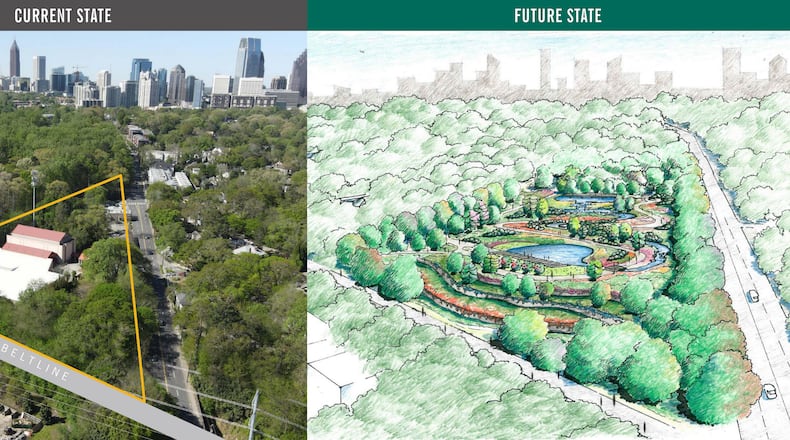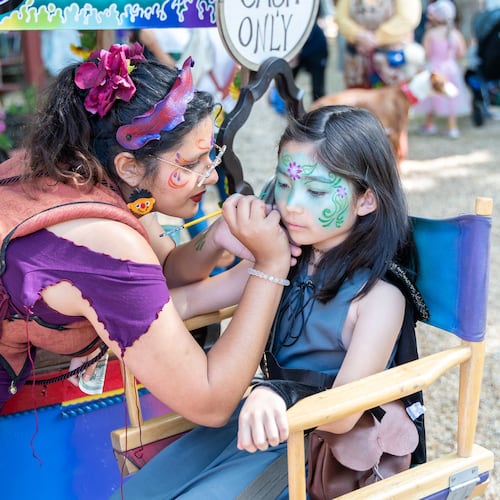The Atlanta Botanical Garden is growing.
Adding its first new acreage since the garden was incorporated in the 1970s, the Midtown greenspace will expand along Piedmont Avenue toward Monroe Drive at its northern tip.
During the last four years the garden’s administrators have, with the help of private donations, been buying commercial properties along Piedmont Avenue that are surrounded by the garden and Piedmont Park.
The parcels they’ve purchased include a clothing store, a dry cleaner, a restaurant, offices and a storage facility. The garden coordinated its efforts with the Piedmont Park Conservancy, which has plans to convert commercial property at the same intersection into parkland.
When both Piedmont Park and the Botanical Garden have completed their plans to grow, they will create a combined green space stretching from 10th Street in the south to just below Ansley Mall. The park, the garden and the Beltline will come together at a “node” in that northern corner.
Mary Pat Matheson, the garden’s president and chief executive officer, said perhaps the most significant aspect of the project is that it will coincide with the completion of the northeastern leg of the Beltline.
This will provide access to the garden to those walking or biking along the popular pedestrian corridor. ”This will transform the way people can get to the garden now,” she said.
Thousands use the Eastside trail every day. The garden plans to draw that group into the facility with a new visitor’s center bordering the Beltline and new attractions in the expanded acreage, such as a conservatory, a water feature and a beer garden.
In general the garden would have resisted opening a second visitor’s center, which would require more personnel and would complicate logistics, “but when we can have an entrance on a major walking corridor, that changes everything,” said Matheson.
She compared the impact on the garden to the impact on the new Whitney Museum in Manhattan, which in 2015 moved from its Brutalist building on Madison Avenue to a prime spot downtown at the base of the High Line pedestrian path. Like the Whitney, the garden will be a major cultural center on a major walking path.
“I think in time the garden will be to the Beltline what the Whitney Museum is to New York City’s High Line,” she said in a statement. “We plan to bring our pioneering spirit to this new part of the garden, combining art, water and gardens in compelling and beautiful displays.”
Credit: Atlanta Botanical Garden
Credit: Atlanta Botanical Garden
The Botanical Garden and its sister green space, Piedmont Park, have been planning parallel expansions since 2018. In 2016, during his final weeks as mayor of Atlanta, Kasim Reed announced at a press conference that the city would commit $20.4 million to buy more land for Piedmont Park.
Since then the city has bought commercial property near that same intersection of Piedmont and Monroe.
Mark Banta, president and chief executive officer of the Piedmont Park Conservancy, the non-profit that manages the park, said the park is planning for the conversion of that commercial property into parkland. It is unclear when that process will begin.
A path carved out for the next phase of the Beltline hugs the entire eastern border of Piedmont Park. When that path is complete, “it will have an incredible pedestrian impact, in a positive way, on the park,” said Banta.
“It’s really a neat coalescence of the Beltline, the garden and the park,” he said. (Most of the Beltline that is contiguous to the park is in the design phase, and construction on that part of the path won’t begin until next spring or summer.)
To dovetail with those changes, during the past four years leaders of the Botanical Garden began seeking contributions from private donors to acquire the “island” of commercial property at its northern end.
Matheson said the total cost of the acquisitions will be about $50 million. When those parcels are secured, she said, the garden will begin clearing most of the buildings. One exception will be the 100-year-old structure on Piedmont Avenue that houses the Boy Next Door men’s clothing store. “We want to preserve history,” said Matheson, “so the goal would be to keep that building and use it for some garden function.”
Credit: Miguel Martinez
Credit: Miguel Martinez
Rocky Carroll, co-owner of the Boy Next Door, said the business has leased the triangular-shaped building since 1980, but they have found another suitable site, near the rainbow crosswalks at Piedmont and 10th.
“We always try to roll with the punches,” he said. “The city is always evolving, and we have to change with it. We don’t really have a choice.”
Matheson said the lead gift for the acquisition funds came from Carol Tome, CEO of UPS, and that an additional gift of $25 million came from the James M. Cox Foundation, the charitable arm of Cox Enterprises, which owns The Atlanta Journal-Constitution.
“The Atlanta Botanical Gardens are a key destination in the Atlanta community,” said John Dyer, Atlanta Botanical Gardens Board Member and former Chairman, as well as a James M. Cox Foundation Trustee, in a press release. “The gardens help people stay healthy and bring joy to the lives of so many. The Foundation was pleased to support the expansion, in addition to the many other ways they help the city of Atlanta.”
In January the garden will launch a capital campaign to fund the creation of the new garden space, estimated to cost around $60 million. Matheson said the city would like to see the project completed in time for the arrival of the World Cup in Atlanta in 2026. “That’s our lofty goal!” she said in a text.
The Atlanta Botanical Garden was incorporated as a non-profit in 1976, and negotiated a long-term lease on approximately 33 acres of city land at the northern end of Piedmont Park. That acreage was reduced slightly in 2006 when the garden traded about three acres of land with the park to build a parking deck, which the two share.
The new developments at the northern tip of the garden will be the first time it has added acreage since its founding, and the additional eight acres will increase the size of the garden by about 25%.
As plans for the expansion were getting in gear, the garden also negotiated another extension of that lease, which now stretches until 2068.
Credit: Jason Getz Photography
Credit: Jason Getz Photography
About the Author
Keep Reading
The Latest
Featured





